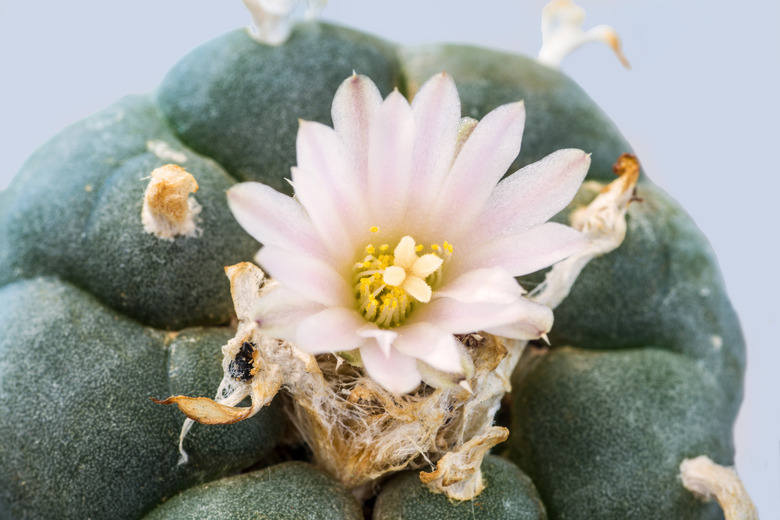Top 10 Plants In The Sahara Desert
People think of deserts as barren, lifeless places. In spite of their harsh conditions, deserts are anything but lifeless. Many animals have found ways to thrive in deserts, and so have many plants. The Sahara desert, located in North Africa, is the largest hot desert in the world and one of the hottest places on Earth with average summer temperatures of 104 degrees Fahrenheit and yearly rainfall of only 1 to 4 inches. Despite the conditions, many plant species thrive in the Sahara. Each of these species developed adaptations to survive the staggering heat and dryness.
TL;DR (Too Long; Didn't Read)
The Sahara desert is the largest hot desert on earth, and one of the hottest, driest place in the world, but many plant species thrive there. These species include the Laperrine's olive tree, the doum palm tree, lovegrass, wild desert gourd, peyote cactus, date palm tree, desert thyme, tobacco tree, tamarisk shrub and Ephedra alata.
Laperrine's Olive Tree
Laperrine's Olive Tree
When you picture a desert, you probably do not picture olive trees. However, in the mountainous regions of the Sahara, the Laperrine's olive tree thrives. These trees are so drought-resistant that some farmers have crossed their cultivated olive trees with Laperrine's olive trees to improve their own trees' hardiness. Unfortunately, due to the impacts of climate change, these trees are now considered endangered.
Doum Palm Tree
Doum Palm Tree
Although many people associate palm trees with the tropics, certain species of palm trees exist in the desert. Some desert palms are extremely long-lived with lifespans of 150 years or more. Other species, such as the doum palm, produce fruits that can be safely eaten by animals. Humans living in or near the Sahara use the rinds of the doum palm's fruit for making molasses. Palm trees have thick trunks that store water for extended periods of time and wide leaves called fronds, which convert massive amounts of desert sunlight into stored sugars to sustain the palm.
Sahara Lovegrass
Sahara Lovegrass
Grasses are some of the toughest plants on earth, and lovegrass is no exception. This plant is widespread in the Sahara desert. It grows in tough clusters and produces small white flowers with edible seeds. Because lovegrass can grow back as long as its water-storing roots remain intact, it can survive in harsh desert conditions. The tangled roots also prevent soil erosion.
Wild Desert Gourd
Wild Desert Gourd
Wild desert gourds, also referred to as creeping plants, are members of the watermelon family that grow abundantly in the Sahara desert. The plants simply do not need much water to survive, as their roots, leaves and fruits store abundant water throughout the year. Desert gourds grow as vines with thin, green leaves. They bear large, round, yellow fruits with thick rinds. These fruits are a good source of food and water for any desert animal strong enough to break through the rind. The desert gourd's large, yellow flowers are also edible.
Nitraria Retusa
Nitraria Retusa
This typically low-growing shrub is found across a broad range in the Sahara (as well as the Arabian Desert). It's often found edging salt marshes (both in coastal and interior desert) and oases and growing along the beds of the dry gullies and washes called wadis. Nitraria retusa commonly forms hummocks or mounds that, in some areas, have been shown to help stabilize sand dunes and thus shape the development of plant communities on these challenging and mobile surfaces.
Date Palm Tree
Date Palm Tree
Of all the trees in the Sahara desert, date palm trees are the most useful to people. The fruits of this tree are used to sweeten beverages or are dried and eaten on their own. The leaves are sometimes used for food as well and can be tender and nutritious when cooked. Like the doum palm, date palms store water in their thick trunks, allowing them to survive in spite of the lack of rain in the Sahara.
Desert Thyme
Desert Thyme
Unlike cacti and palm trees, which store water inside their thick bodies, desert thyme does not use much water in the creation of its stalks, leaves and flowers, and it doesn't need much water to maintain them. This survival strategy gives thyme a shrubby, dried-out appearance. However, the plant is extremely successful at surviving desert conditions. Thyme is often used by people as a flavoring herb in cooking.
Tobacco Tree
Tobacco Tree
The tobacco tree is not native to the Sahara desert but grows there as an invasive species. These plants were originally from South America but were brought by settlers to other continents. Unlike some forms of tobacco plant, the leaves of the tobacco tree can be lethal if smoked. This plant can grow to heights of over 6 feet and has small leaves, which prevents the desert sun from drawing away moisture. The tobacco tree also stores water in its roots.
Tamarisk Shrub
Tamarisk Shrub
Tamarisk is a small, shrubby plant native to the Sahara. Unlike many desert plants, it does not store much water in its roots or body. Instead, it uses little water to maintain itself, so its need for water is low. Its leaves and flowers are dry and scalelike. Like desert grasses, tamarisk shrub roots help to decrease soil erosion.
Ephedra Alata
Ephedra Alata
Another shrubby desert plant, Ephedra alata has a similar survival strategy to the tamarisk shrub. This plant has adapted to use little moisture, yet it thrives even though it appears dried out. This plant has long been used in the traditional medicines of people living in or near the Sahara desert.
Cite This Article
MLA
Cook, Maria. "Top 10 Plants In The Sahara Desert" sciencing.com, https://www.sciencing.com/top-10-plants-sahara-desert-6941228/. 12 April 2019.
APA
Cook, Maria. (2019, April 12). Top 10 Plants In The Sahara Desert. sciencing.com. Retrieved from https://www.sciencing.com/top-10-plants-sahara-desert-6941228/
Chicago
Cook, Maria. Top 10 Plants In The Sahara Desert last modified March 24, 2022. https://www.sciencing.com/top-10-plants-sahara-desert-6941228/
